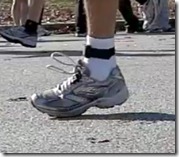 Over the past year I have written quite frequently on the topic of footstrike in running. Simply defined, footstrike represents the moment of initial contact of the foot with the ground, and individual footstrikes are typically categorized in the scientific literature (e.g., Hasegawa, 2007) in one of three ways : 1. rear-foot or heel strike, in which initial ground contact is one the posterior 1/3 of the foot/shoe; 2. mid-foot strike, in which initial contact is made on the middle 1/3 of the foot/shoe (more-or-less flat along the lateral edge of the sole); and 3. forefoot strike, in which initial contact is made with the anterior 1/3 of the foot/shoe (no heel contact at footstrike).
Over the past year I have written quite frequently on the topic of footstrike in running. Simply defined, footstrike represents the moment of initial contact of the foot with the ground, and individual footstrikes are typically categorized in the scientific literature (e.g., Hasegawa, 2007) in one of three ways : 1. rear-foot or heel strike, in which initial ground contact is one the posterior 1/3 of the foot/shoe; 2. mid-foot strike, in which initial contact is made on the middle 1/3 of the foot/shoe (more-or-less flat along the lateral edge of the sole); and 3. forefoot strike, in which initial contact is made with the anterior 1/3 of the foot/shoe (no heel contact at footstrike).
What these categories fail to do, however, is capture the degree of variation that is present on an individual level when considering the complexity of the initial foot-ground interface. What we commonly refer to as a heel strike can come in a number of different forms (e.g., degrees of foot dorsiflexion or upward toe pointing, exact position of contact on the heel), and these likely carry along with them different properties in terms of impact forces experienced, loading rates, etc. Even a midfoot strike, which is much less variable in terms of foot dorsiflexion, can vary highly in the amount of inversion/eversion of the foot at contact.
I’m not going to go into a lot of detail about these subtleties of footstrike here, but rather wanted to post a series of photos captured from high speed videos that were taken by my students at mile 20 of a marathon last year. If nothing else, these photos should give you a good feel for at least a small amount of the variability present in the human running footstrike. You can also see some variability in the degree of flexion at the knee. I’ll touch on the significance of some of these variations in coming posts, but thought there might be interest in seeing these images give the amount of discussion regarding the topic of running footstrike that has occurred in the past year or so.
I’ve roughly ordered these from the most extreme heel strikes all the way down to a single forefoot strike (there is a second, more extreme, forefoot strike in the opening photo of this post), and each photo represents the exact moment where the foot first contacts the ground (these were taken from video recorded at 300 frames-per-second, so point of initial contact could be determined with a high degree of accuracy).
I’d love to hear any thoughts you might have in the comments!

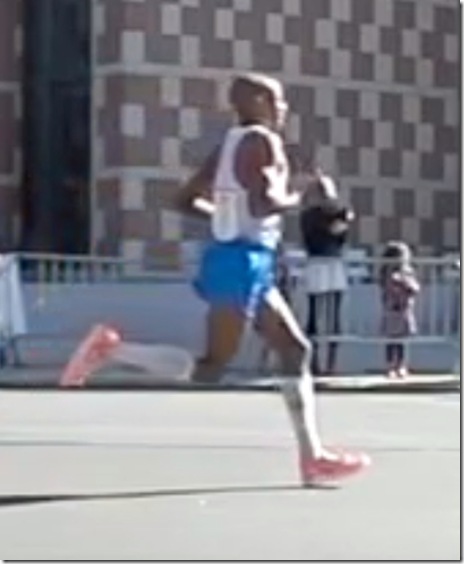
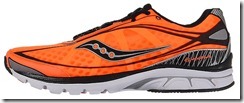
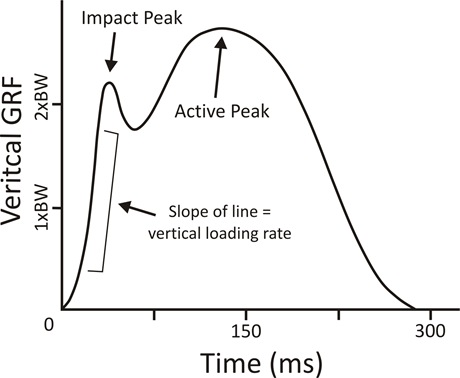

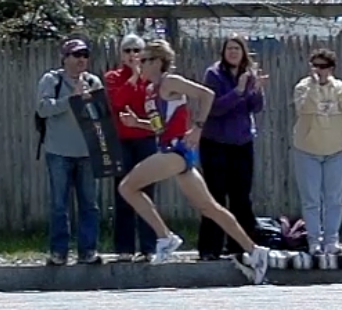














Is this at the Manchester Marathon? Did you get video of all the runners?
Yes – most of them. Were you there? If so, I can check for your videos.
Pete
Yes, I did it one week after doing the Cape Marathon and was experimenting (probably foolishly) with shoe inserts. I am sure my foot was doing more than the funky things it usually does without inserts. I finished in 3:29:22. Here is my report on running with the inserts last year: http://recoveryourstride.blogs…
Jim
The VFF runner has the most horrifying foot strike of the lot! He’s landing ahead of his Centre of Gravity, his leg is almost locked out AND he’s heel striking. In VFFs!!! That won’t be doing him any good at all.
Good catch, Paul! In my initial glance at the photos I hadn’t noticed that one of the most severe heel strike and leg lock was definitely the VFF runner. Worse yet, is that he’s doing that on a very hard surface. Won’t be long before he either fractures his calcaneus or he changes his footstrike pattern.
Regarding the VFF runner, he’s actually a friend of mine and he openly
admits to being a VFF heel striker. Amazing thing is that he has not
been seriously injured despite 1000’s of VFF miles and 3 marathons.
Goes to show how everyone’s a bit different. As for that specific
picture, it was his first VFF marathon and at that point I believe it
was the longest he had ever run in VFFs. His quads locked up shortly
after that image was taken, so what we may be seeing there is a
prelude to the breakdown that occurred shortly thereafter.
While the VFF runner is landing with very straight leg and heel striking of all the runners he is landing with his foot the closest to his center of gravity. *All* runners have to land with their foot in front of their center of gravity, when running at a steady state, as you’d fall flat on your face otherwise. That’s why all of the photo’s here and anywhere else you’ll find the landing with foot in front of the center of gravity.
The idea of landing in front of center of gravity being poor form is very wrong, you can’t have a running form that is physically impossible being good running form, and all the physically possible forms being bad. Yes Chii Running, Good Form Running etc. are teaching something that can’t happen in the real world.
In the case of VFF runner, he’s landing close to center of mass, and he’s trailing leg is only a small angle behind indicating to me that of all the runners in the shots he’s probably running with a shortest stride and slowly at the point of the photo. I’d guess he’s jogging here, while most of the photo’s here the legs are far more open indicating that they are running with longer stride and at a faster rate.
Pete’s has added that the VFF runner shortly afterwards suffered from his quads locking up, so it might well be likely that he was slowing and changing to more of shuffle gait to avoid bending his knees as an attempt to less the load on fatigued quads. It would be interesting to look at photo’s of the runner prior to fatigue settings in.
Excellent points Robert – I’ll see if I can put up a “before” picture of the
VFF runner.
Amazing the amount of variety in the human body. I am thinking of also recording my foot strike pattern to see where it stands. I am almost sure I am now a mid-foot striker, but the images may somehow show something different. From the pictures, I agree with Paul that heel strike with VFF may not be a good idea, although I know from a previous post that you know someone who does that. If you have recorded most of the runners, have you collected any statistics? I would really appreciate to know how many people are mid or forefoot strikers, although, at this point, I assume most of the people are (still) heel strikers. It would be interesting to check how it evolves as time goes on. I am looking forward for your following posts on the subject.
Regards,
Sergio
Brazil
I have a lot of statistics on this, but am working on getting them
published in a scientific journal before posting anything here – stay
tuned!
Really interesting Pete. Another fascinating area to study is the degree to which a runner lands on the lateral side of the foot. The 18th photo above really captures this and shows that some runners do land on the extreme outside edge of the foot. How does this affect impact forces? Efficiency? Injury potential?
Also, look at the VFF runner landing on his heel! Amazing how that’s even possible on pavement.
Good point – few people consider inversion vs. eversion at contact.
Everyone is so concerned with pronation after contact, but it helps to
also consider the starting point, as that one photo shows so well.
If we filmed 100 people running in VFFs, my gut is that you’d be
surprised at how many still heel strike.
I have been running in my VFF’s for a couple of years, and now I probably use them for the majority of my runs. As I have pushed the distances that I run in them I’ve noticed a significant increase in heel striking once I’m fatigued. So on longer runs I’ll experience a pretty significant change in foot strike from the beginning of the run to the end.
Yep, people underestimate what fatigue can do to running form!
Great post. Most of the running injury problems I get to participate with & help heal can be traced back to (my own anecdotal evidence) extreme heel strike. We use video analysis like this to help them correct form.
Once again this is an amazing post. The knee extension and heel strike of the runner in VFF is surprising!
I just added some info about the VFF runner above in the comments.
So many more questions, but I’m sure you’ll get to them in due time. For now, I’m impressed and surprised by those who are hard heel-striking but with a reasonably flexed knee.
Yes, that amazed me too. Looks very awkward to have such a degree of
knee flexion combined with extreme dorsiflexion of the foot – it’s
very similar to what Meb does. I wish I had injury history data for
each of these runners. The only one I do know well is the VFF runner,
and he has no history of major injury, but is like me a relatively new
runner.
Great photos, but I feel like the pace of each runner should be posted too. Take the VFF runner for example, if he’s running a 7 min pace wouldn’t the impact be significantly higher compared to a 10 min pace?
I intentionally held out a lot of data here as I am working up a
publication on this stuff and trying not to give away too much. I have
final race times for each of these runners, as well as synced video
from earlier in the race (mile 6). You are right though – speed leads
to greater impact, and some of the most extreme heel strikes you see
here were among the fastest runners in the race.
I think it’s also interesting to look at variation within a particular runner’s foot strikes (depending on the stage of the race, the left vs. right side, or any other factor). I’ve noticed that my right foot has a severe heel strike, while my left foot lands more in the mid-foot.
I have all of that data actually – both for left/right asymmetry and
patterns at mile 6 vs. mile 20 for individual runners. Trying to get
it published first, then more will come out here on the blog.
Great job Pete. So from the photo, one could conclude one does not need VFF to improve one’s foot strike (mid foot vs heal). I have noticed a big difference in how I run going from a traditional shoe to the Kinvara.
Not necessarily as the VFF runner is just one data point and he is a friend
who claims to always heel strikes in his Vibrams. I’d say that they were a
big help to me in my transition, but it can certainly be done with other
shoes given some effort to work at it. Glad to hear the Kinvaras are working
for you!